Museums need effective museum storage solutions to protect valuable pieces of fine art and manage collections. Museum curators play a crucial role in managing these collections and storage solutions effectively. This article explores high-density shelving, bespoke cabinets, and climate-controlled storage.
Key Takeaways
- Museums face significant storage challenges due to space limitations, necessitating the implementation of high-density and customised storage solutions to preserve collections and enhance accessibility.
- Advanced storage systems, such as mobile shelving are critical for protecting sensitive artefacts and improving organisational efficiency within museum facilities.
- Funding opportunities and the selection of qualified storage solution providers are essential for museums aiming to upgrade their storage capabilities and ensure the long-term preservation of their collections.
Understanding Museum Storage Needs
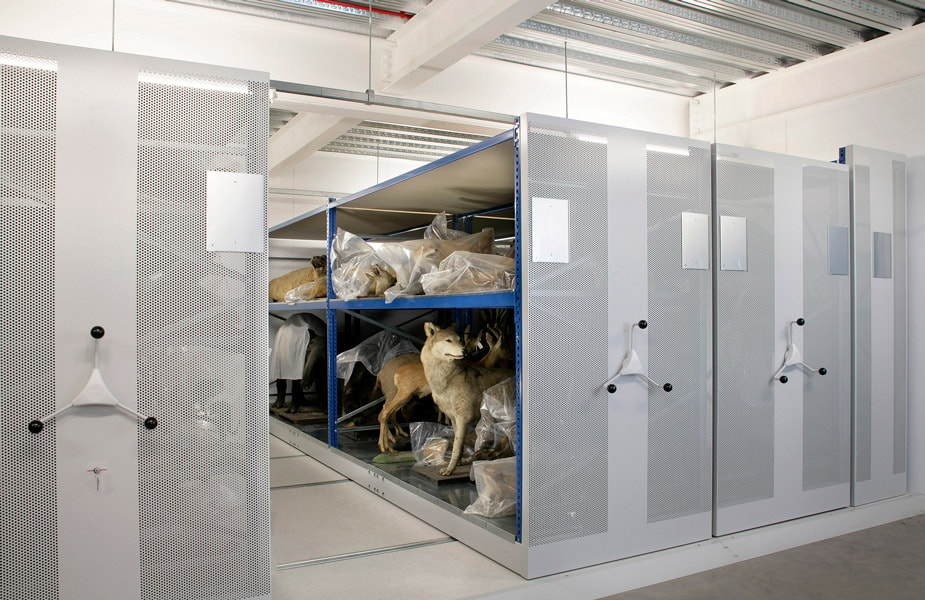
Museums often face the challenge of space limitations, restricting their ability to display all their collections. Museum storage systems are essential for preserving artefacts, documents, and artwork, providing protection and space efficiency through customised solutions tailored to different types of museum collections.
Overcrowding in storage areas can lead to damaged and lost items if not managed properly. This makes space efficiency crucial, especially for temperature-controlled storage, which is both expensive and necessary for certain artefacts. High-density storage systems can help museums manage increasing collection sizes more effectively, ensuring that each item is stored securely and accessibly.
Moreover, choosing appropriate materials for storage and display is vital to prevent chemical reactions that could damage museum objects. Customised storage solutions play a key role in securely storing various artefact types, helping to maintain their integrity and making it easier for curators to access items for exhibitions and loans.
Types of Museum Storage Solutions
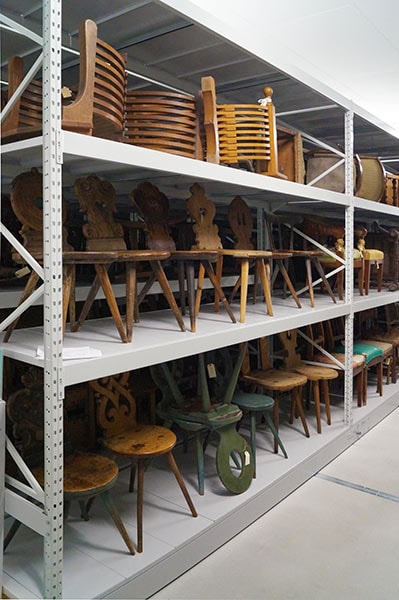
Optimising storage space in museums is essential for efficiency, organisation, and the protection of collections. As museum collections continue to expand, the demand for flexible and customised storage options increases. Various high-density storage solutions, including static and mobile systems, help in optimising museum storage effectively.
Let’s explore some of the key types of storage solutions available.
High-Density Shelving Systems
High-density shelving systems are a cornerstone of effective museum storage solutions, allowing institutions to maximise their available space. These systems can significantly increase accessibility for museum staff, making it easier to manage and retrieve artefacts. Freeing up extra floor space ensures a more efficient use of museum storage areas.
Flexible manufacturing processes allow for shelving and art racks of any height, ensuring optimal use of vertical space. This adaptability is crucial for museums, as it allows them to customise their storage systems to fit the unique needs of their collections.
Mobile storage systems are a highly efficient choice for museums, capable of recovering up to half of valuable floor and volume space. These systems optimise the use of available space, allowing museums to store more items without sacrificing accessibility. This approach benefits institutions by expanding collections and providing limited storage space.
Customised storage options provided by mobile systems help preserve valuable pieces by fitting specific collections. Optimising floor space allows museums to accommodate more collections and improve accessibility for staff and visitors.
Picture Racking
Whether it is individual paintings or complete collections, art storage and archiving valuable items is always a significant challenge. This is precisely why the installation of art archives requires detailed know-how and complex competence.
When designing and sizing archiving systems for artwork, the building’s structure plays a crucial role in determining how well individual requirements can be met. The final system selection hinges on the archiving method and capacity, but ease of use remains the top priority.
No matter how challenging the scope and function of a project, Ecospace has the optimal solution tha covers all requirements, including in particular ease of use. Pull-out and sliding elements make sure that archivists will stay on top of their collections.
Pull-out picture panels
When it comes to archives for artwork and collections, the emphasis is always on space-saving and flexible system solutions. We offer two designs that reflect two different requirements:
- Panels running on floor rails.
- Panels suspended from above.
Mobile picture panels
Mobile picture panels guarantee the best possible use of the available space. The only aisle to be opened is the one in immediate use, so this system offers almost double the storage capacity of a stationary system.
More storage space without occupying more surface area. This system is perfect for efficiently organising various art materials.
Stationary picture panels
Stationary picture panels offer hanging space on either or both sides and are flexible in their dimensioning. They can also be wall-fixed to optimise any storage space. These panels are also suitable for storing paints and other art supplies.
Display Cabinets
Bespoke museum storage display cabinets are essential for the safe and secure storage of various artefacts, including art storage. Bespoke storage cabinets can be designed to accommodate specific types of artefacts, enhancing their protection. This is particularly important for items that require special handling or environmental conditions. An efficient storage room is crucial for storing artworks, ensuring smooth installation processes and optimal space utilisation.
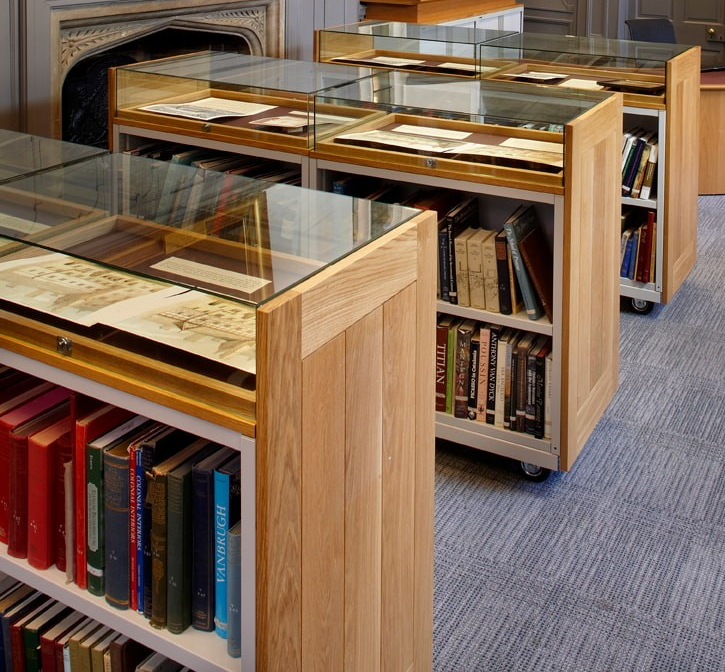
Large and outsize formats store drawings storage
Objects that need to be stored horizontally, including flags, carpets, or fabrics, including drawings and maps, need to be stored properly with due care to store drawings safely.
Flat File cabinets are ideal for storing large and outsize formats.
Advantages:
- Optimal dust protection.
- Continuously variable drawer height.
- Accessible from both sides.
- Holds large and outsize formats.
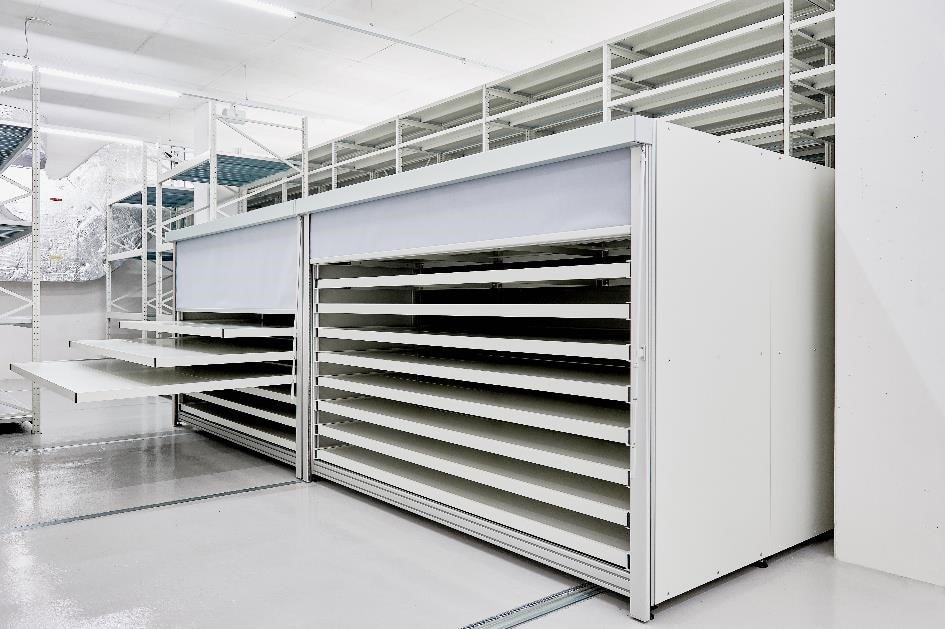
Specialised Storage for Different Collections
Specialised storage solutions protect various types of collections storage from damage and environmental factors. Modern systems incorporate advanced technology and modular design to preserve and manage museum collections effectively.
Successful museum storage projects often focus on tailored solutions to meet the specific needs of diverse collections.
Document Storage
Specialised solutions are necessary for document storage to prevent deterioration and ensure easy access. Archive shelving and storage equipment securely store archival documents.
Artefact Storage
Artefact storage requires tailored solutions to preserve diverse and delicate items. Museum storage cabinets are ideal for light-sensitive art pieces, helping to prevent deterioration. Herbarium and botany storage cabinets, for instance, are crucial for effectively preserving delicate specimens.
Garment and costume storage racks preserve items, ensuring they remain in pristine condition.
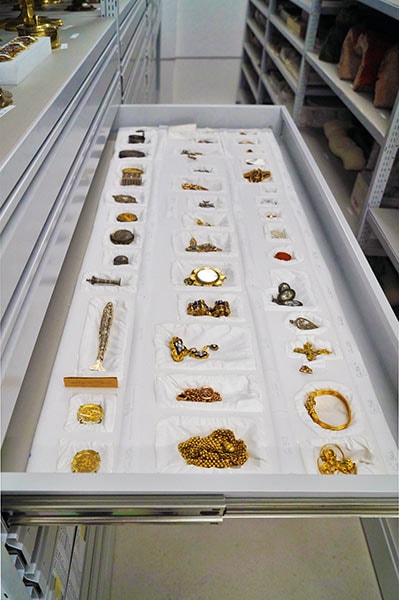
Accessibility and Organisation
Effective storage solutions must also prioritise accessibility and organisation. Modern systems often feature compartmentalised areas that improve organisational efficiency and facilitate easy access to various collections. This reduces retrieval time and enhances the museum staff’s overall workflow.
Specialised storage options like mobile shelving can enhance the organisation and accessibility of various artefacts. Utilising free planning services from storage solution providers helps museums optimise layouts, save costs, and ensure the safety of artefacts while maximising storage efficiency.
Choosing the Right Storage Solution Provider
Choosing the right storage solution provider is crucial for museums to ensure their collections are preserved and protected effectively. Key factors include expertise, sustainability goals, and a proven track record in conservation.
Evaluating Providers
Evaluating storage solution providers should include considering their proven track record in similar projects, and showcasing their reliability and effectiveness. Providers should offer customisation options tailored to the unique needs of each museum.
Summary
In summary, effective museum storage solutions are essential for preserving, organising, and securing valuable collections. From understanding the specific storage needs of museums to exploring various types of storage systems, specialised storage for different collections, and the role of sustainable materials, it is clear that tailored solutions are vital.
Frequently Asked Questions
Museums require specialised storage solutions to safeguard their collections from potential damage and environmental threats while optimising space and facilitating access to research and exhibitions. This ensures the longevity and integrity of valuable artefacts.
High-density shelving systems optimise space and enhance accessibility for staff while also ensuring the secure storage of artefacts. This approach significantly improves overall efficiency in museum management.
Mobile storage systems significantly enhance museums by maximising floor and volume space, enabling the storage of more items while maintaining accessibility. Additionally, they provide tailored storage solutions that cater to specific collection needs.
Recent Comments